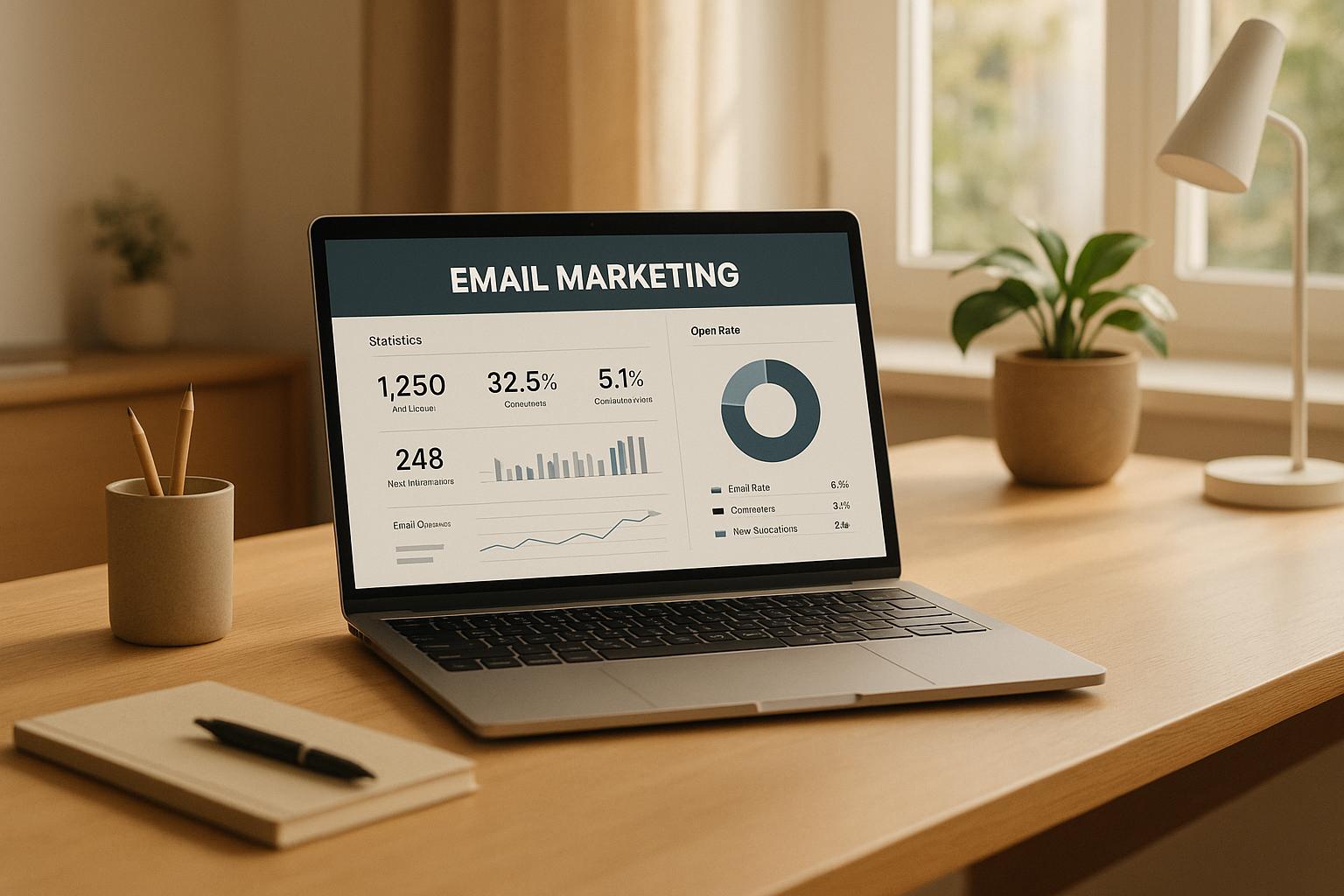AI is no longer just for big corporations. In 2025, small businesses across the U.S. are using free AI tools to simplify operations, cut costs, and grow faster. Tasks like marketing, customer support, and scheduling are now easier and faster, thanks to accessible, no-cost AI platforms. These tools don’t require tech expertise or big budgets, making them perfect for small businesses looking to stay competitive.
Here’s a quick look at seven free AI tools helping small businesses thrive:
- AI Apps: A directory with over 1,000 free tools for various business needs.
- Canva: Create professional designs for branding and marketing.
- HubSpot CRM: Manage customer relationships and sales at no cost.
- Grammarly: Improve writing quality for emails, posts, and documents.
- Hootsuite Free Plan: Schedule and analyze social media posts.
- Zapier Free Plan: Automate repetitive tasks across apps.
- ChatGPT Free Tier: Generate content, brainstorm ideas, and assist with customer service.
These tools help small businesses save time, improve efficiency, and focus on what matters most - serving customers and growing. Start with one tool to address a pain point, then expand your toolkit as you see results.
5 Best AI Tools for Small Businesses in 2025
How Free AI Tools Help Small Business Growth
Free AI tools are leveling the playing field for small businesses, offering access to advanced technology without the financial burden. With no upfront costs or subscription fees, these tools let small business owners experiment freely, without worrying about draining their budgets or committing to long-term contracts that may not deliver.
One of the standout benefits is how quickly these tools can be set up. Imagine a local restaurant implementing automated customer service responses in under an hour or a consulting firm launching AI-powered scheduling tools on the same day they discover them. This quick setup means businesses can start seeing results almost immediately - sometimes within days.
Another advantage is scalability. These tools grow with your business without requiring expensive upgrades. For instance, a freelance graphic designer can rely on the same AI writing assistant, whether they're managing five clients or fifty. As the business scales, additional features are often available without needing to switch platforms.
Most free AI tools are also designed to be user-friendly, with minimal learning curves. Unlike complex enterprise software that demands extensive training, these tools cater to everyday users. A small business owner could learn basic social media scheduling powered by AI in just a few hours, then gradually explore more advanced features as they gain confidence.
Key Selection Criteria for US Small Businesses
When it comes to choosing the right free AI tools, there are a few key factors to keep in mind:
- Reliability: Dependable performance is non-negotiable. Small businesses need tools with uptime rates above 99% to avoid disruptions during critical operations. A glitchy tool can mean lost customers or missed opportunities.
- Security: Protecting customer data is especially important for US businesses. The best free AI tools use enterprise-grade encryption and have clear data handling policies. They should specify where data is stored, how long it’s retained, and whether it’s used for training purposes. Tools that comply with state laws like the California Consumer Privacy Act offer added assurance.
- Integration: Seamless compatibility with existing systems is a must. The most effective free AI tools easily connect with popular platforms like QuickBooks, Gmail, or your website. Native integrations help reduce manual work and minimize errors.
- Compliance: Beyond privacy, compliance with US regulations is crucial. Tools should support proper tax record-keeping, provide audit trails for financial transactions, and allow data exports in standard formats. This makes it easier to collaborate with accountants and meet regulatory requirements.
- Transparency: Business owners need to understand the limits of free tools. The best options clearly outline usage caps, explain what happens when limits are reached, and offer simple upgrade paths. Hidden restrictions can lead to disruptions that harm customer trust.
- Support: When technical issues arise, responsive customer service and helpful resources make all the difference. Free AI tools backed by detailed documentation, active user communities, and quick support channels offer better value in the long run.
The smartest small businesses adopt these tools gradually. Instead of overhauling their operations overnight, they start by addressing a single pain point - like automating email responses or improving scheduling. Once they’ve mastered that tool, they expand to other areas, building confidence and creating a solid foundation for more advanced integrations. Up next, we’ll explore the central directory provided by AI Apps for accessing free AI tools.
AI Apps: A Central Directory for Free AI Tools
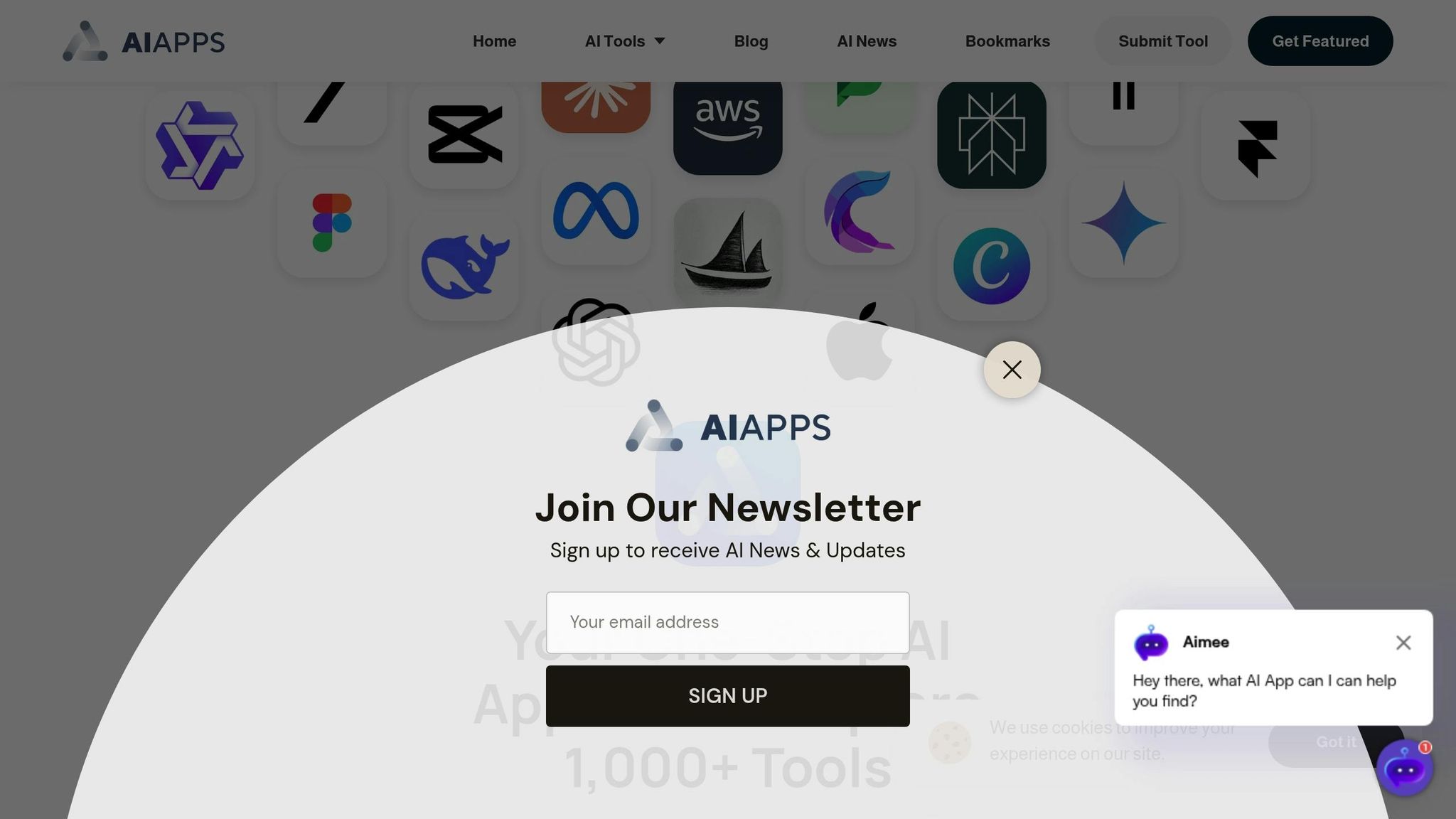
Budget constraints can make finding the right AI tools for your small business feel like searching for a needle in a haystack. That’s where AI Apps steps in. This platform offers a curated directory of over 1,000 AI tools, neatly organized into categories, making it easier for small businesses in the U.S. to explore and compare solutions that fit their needs.
The tools are grouped into specific categories like AI Art, AI Text, AI Video, and automation, helping business owners quickly pinpoint the functionality they’re seeking. Whether you’re looking to create marketing materials, automate customer service, or streamline daily operations, AI Apps saves you the hassle of scouring countless websites.
To make things even simpler, the platform includes advanced filtering and search options. You can filter tools by pricing - separating free options from paid ones - or narrow your focus to specific sub-categories. This means less time spent searching and more time implementing solutions that can benefit your business.
But it’s not just about convenience - quality matters too. AI Apps stands out by using a multi-step verification process to ensure the tools listed meet high standards. This helps business owners avoid unreliable or outdated options. Plus, the directory stays up-to-date with submissions directly from developers.
On top of tool discovery, AI Apps also offers a blog packed with educational resources. These articles provide insights into AI trends and practical strategies, helping small business owners make the most of these cutting-edge tools. Whether you’re new to AI or looking to deepen your understanding, these resources can guide you every step of the way.
1. AI Apps
AI Apps is a go-to directory for discovering free AI tools designed to simplify and enhance your business operations. With a collection of over 1,000 AI applications neatly categorized, it makes finding the right tools a breeze. Let’s explore why its free tier is an excellent option for businesses looking to save costs while staying efficient.
Free Access for Budget-Conscious Businesses
For small business owners, cost is often a major concern. AI Apps offers a completely free platform where you can browse its extensive directory, use advanced filters, and access detailed information about each tool - all without spending a dime. The filtering system clearly distinguishes free tools from paid ones, allowing you to focus solely on free options and build your AI toolkit with full pricing clarity.
Tailored to Small Business Needs
Small businesses often face challenges distinct from those of larger enterprises. AI Apps addresses these by categorizing tools based on practical business functions rather than complex technical details. Whether you’re looking for AI Art Generators to create marketing visuals, AI Text Generators for crafting content, or workflow automation tools to streamline operations, the platform makes it easy to find solutions that fit your specific needs.
Adapts as Your Business Grows
As your business grows, AI Apps evolves with you. The platform ensures the quality of its listed tools through a multi-step verification process, so you can rely on them both now and in the future. Regular updates, including new submissions from developers, keep the directory fresh with the latest AI advancements. Whether you’re just starting out or transitioning to tools like Canva as your operations expand, AI Apps remains a reliable resource.
2. Canva
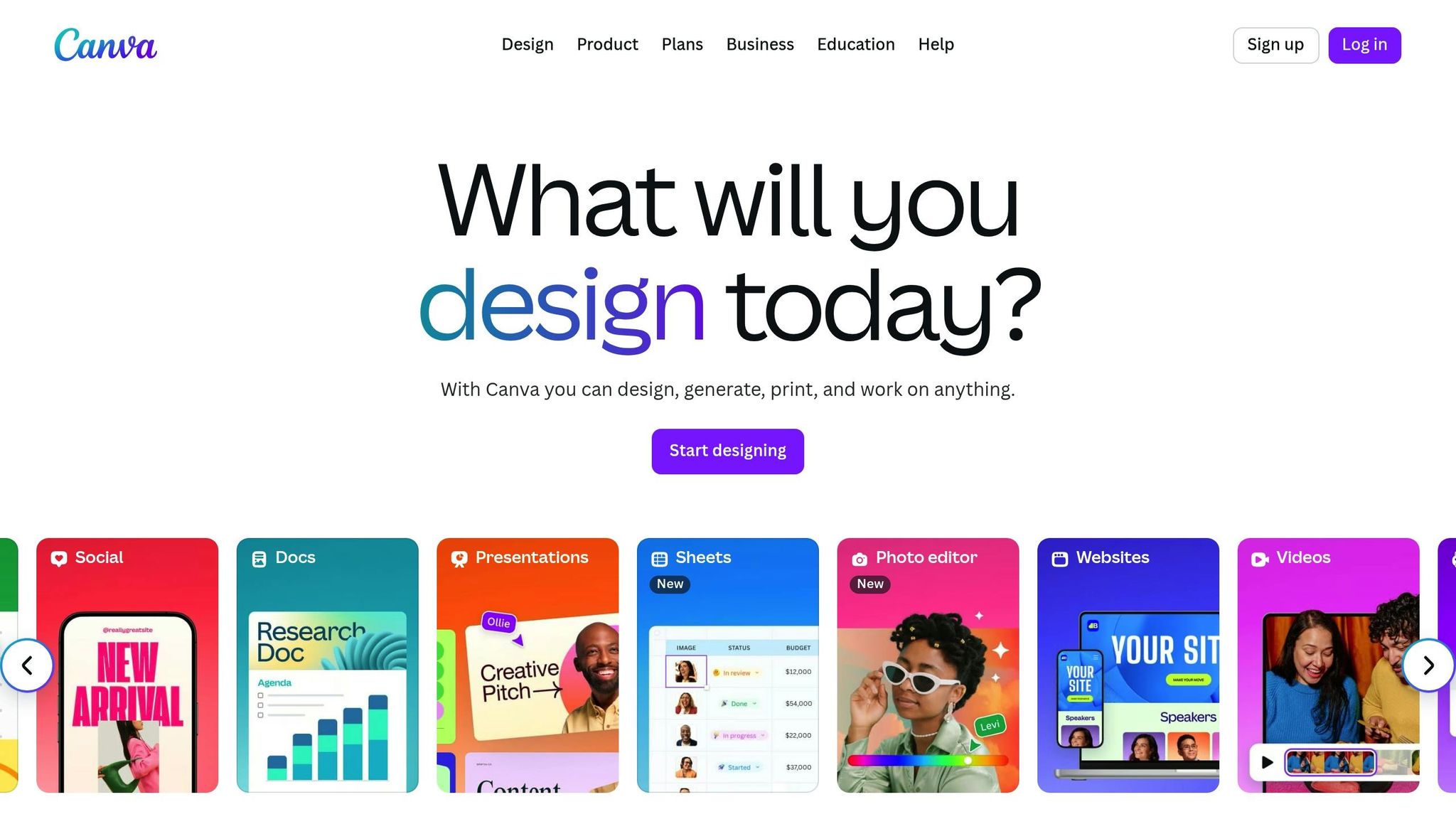
Canva makes it possible for small businesses to create professional-quality graphics without needing a background in design. This user-friendly platform offers a free plan that equips business owners with tools to craft visually appealing content. Let’s break down how Canva supports small businesses in terms of cost, branding, integration, and adaptability.
Cost-Effective Design Tools
Canva’s free plan is packed with features that let you design everything from social media posts to business cards and presentations. With a wide selection of templates, photos, and design elements, you can create polished visuals in no time. The platform even includes tools like automatic resizing for different formats, saving you hours of manual adjustments. Plus, the background removal feature simplifies image editing, cutting out the need for costly professional services.
Tailored for Small Business Branding
Maintaining consistent branding can be tricky for small businesses, but Canva makes it easier. You can save your brand colors, fonts, and logos, ensuring that all your materials - from social media posts to proposals - look cohesive. Canva’s intuitive layout suggestions also help you create eye-catching designs quickly, whether you’re promoting a daily special or crafting a presentation for potential clients.
Seamless Integration with Other Tools
Canva works smoothly with tools you’re already using. You can share designs directly to platforms like Facebook, Instagram, LinkedIn, and Twitter without needing to download and re-upload files. It also integrates with cloud storage services like Google Drive and Dropbox, making it easy for your team to access shared assets. Additionally, connections with email marketing and collaboration tools streamline the process of designing, reviewing, and sharing content.
Built for Growth
As your business grows, Canva’s collaborative features let your team work together on projects while keeping your branding consistent. These tools help manage workflows efficiently, ensuring that every design aligns with your company’s style and standards. Whether you’re a solo entrepreneur or managing a growing team, Canva scales with your needs.
3. HubSpot CRM
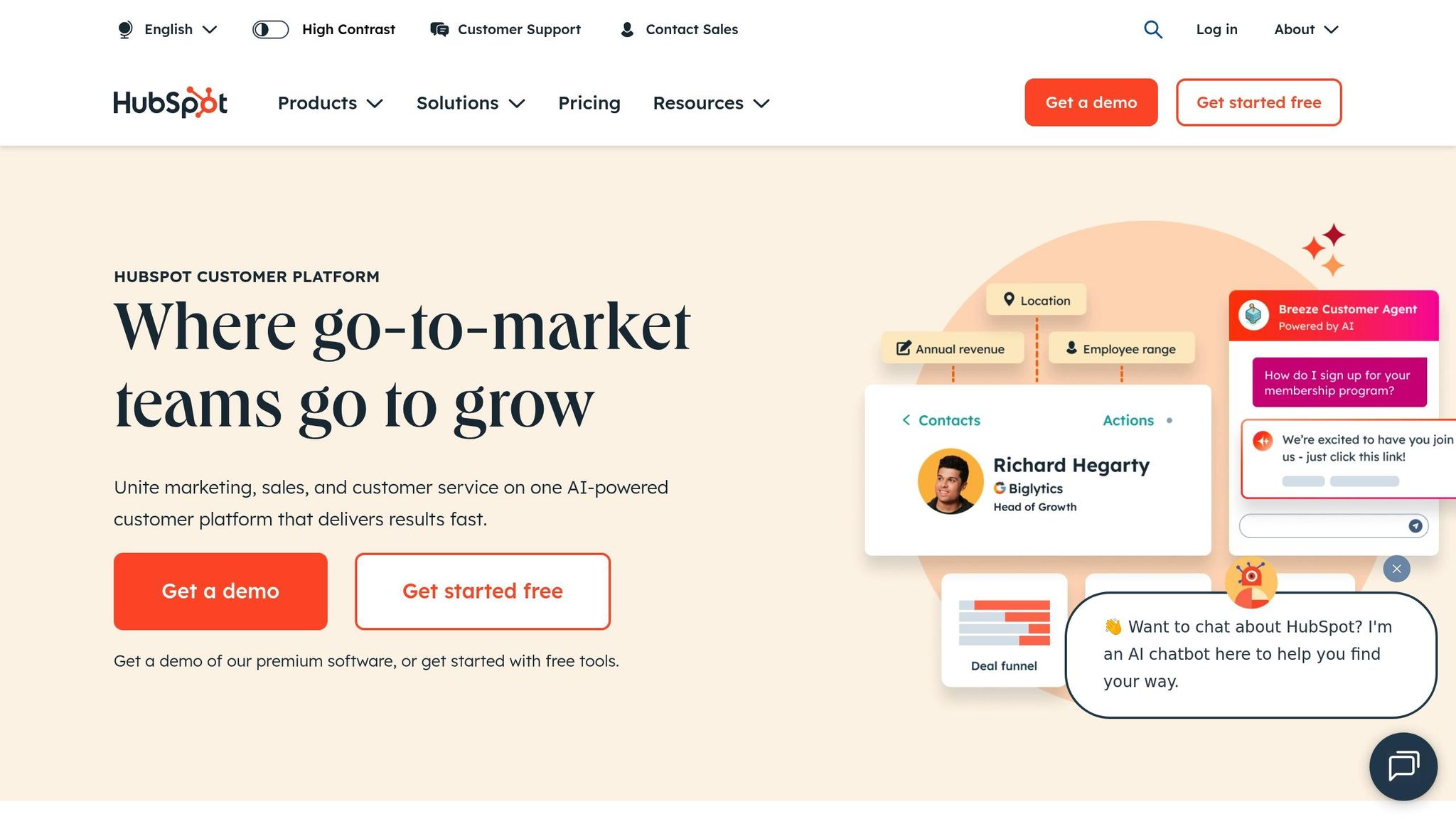
HubSpot CRM is a customer relationship management platform designed to help small businesses manage their customer relationships effectively. What sets it apart is its free tier, offering a range of tools that can support growth without adding to your budget.
Free Tools That Pack a Punch
The free tier comes with some great essentials for managing sales and customer interactions. For example, email tracking lets you know when a prospect opens your email, making it easier to follow up at the right time. Plus, it includes calendar tools that simplify scheduling - just share a meeting link, and you're good to go. These features work together to streamline how you interact with your customers.
Tailored for Small Business Needs
HubSpot CRM is built with small businesses in mind, offering a centralized place to manage customer data. It integrates with Gmail and Outlook, so your emails automatically sync, and your contact list stays updated as you communicate. This means no more juggling between tools or losing track of important details.
Easy to Use and Ready to Grow With You
One of the best parts about HubSpot CRM is how easily it fits into your existing workflow. You can stick to your usual email habits while gaining extra insights about your customers. And as your business expands, the free tier provides a solid starting point for scaling up. With built-in analytics, it’s easy to refine your sales and marketing strategies as you grow.
4. Grammarly
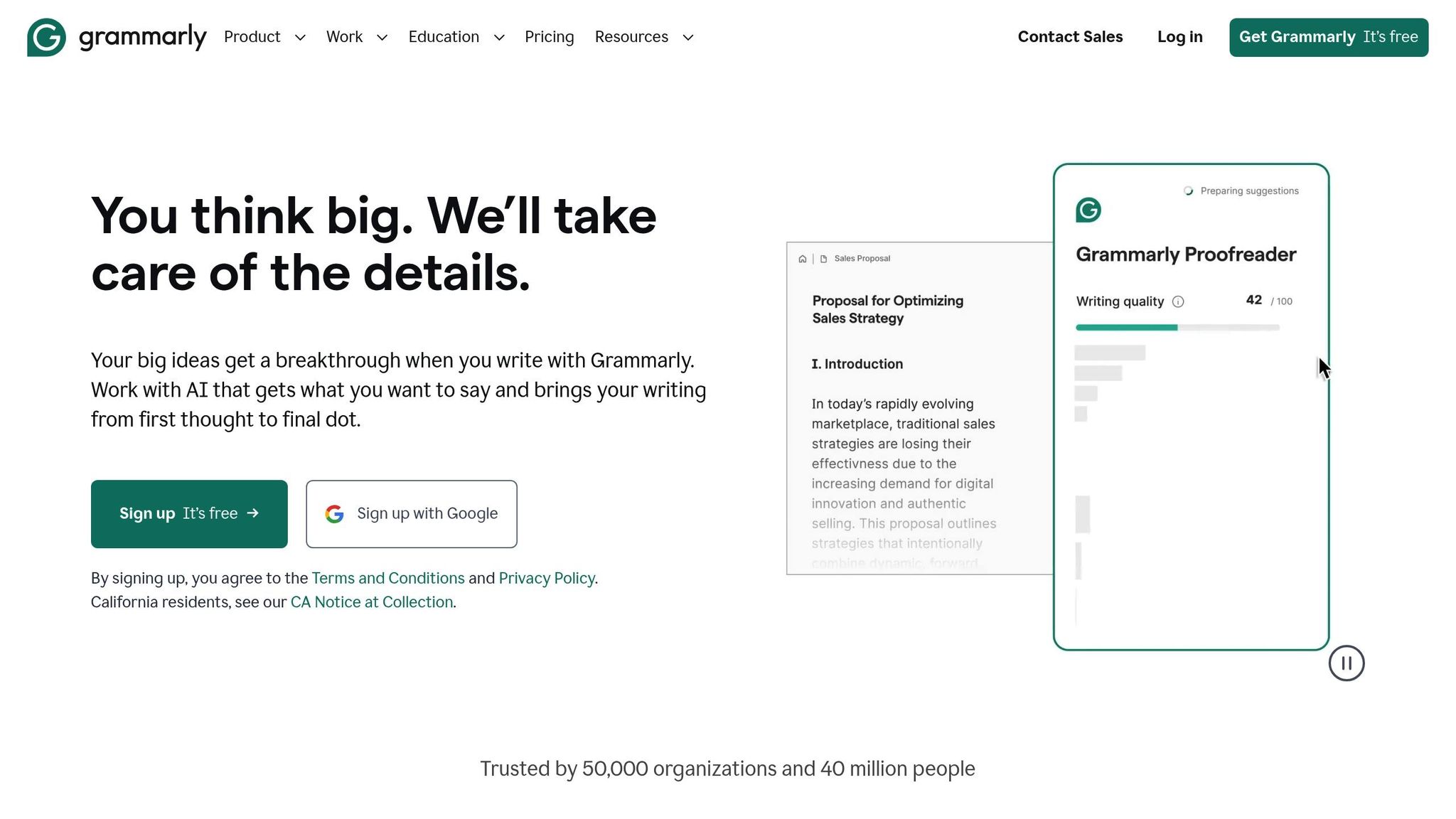
Grammarly is an AI-powered writing assistant designed to help small businesses create polished and professional content without the need for dedicated editors or proofreaders. Its free version provides essential tools to improve business communication.
Cost-effectiveness (Free tier functionality)
Grammarly's free tier delivers essential writing tools like grammar and spelling checks, punctuation corrections, and tone detection. These features help eliminate errors in emails, social media posts, and marketing materials, ensuring your communications remain professional and credible.
Grammarly’s internal data from 2024 reveals that users make 86% fewer writing mistakes on average after consistently using the tool. For small businesses, this means fewer miscommunications with clients and more trustworthy messaging across all platforms. It’s a practical solution for businesses without the resources to hire editorial staff.
Relevance to small business needs
AI tools like Grammarly are a game-changer for small businesses that lack dedicated editors. In fact, 57% of small business owners say these tools help them compete more effectively with larger companies. Clear, professional communication fosters trust with customers and partners, which is essential for long-term growth.
For example, one consulting firm reported a 30% drop in client misunderstandings and a noticeable reduction in editing time after adopting Grammarly. These outcomes highlight how tools like Grammarly directly improve business operations and strengthen customer relationships, making them indispensable for small businesses in 2025.
Ease of integration with existing tools
Grammarly integrates seamlessly with the tools your business already relies on, such as Gmail, Google Docs, Microsoft Office, Slack, and most web browsers. This allows your team to access writing assistance without disrupting workflows or switching between applications.
The browser extension activates automatically when typing in email clients, social platforms, or content management systems. This ensures your communications maintain a high standard of quality as your business grows.
Scalability for growing businesses
Grammarly is designed to evolve with your business. While the free tier addresses most small business needs, the platform offers premium plans for growing teams. These upgrades include features like plagiarism detection, custom style guides, and team management tools.
Even as your business scales, the free version remains a reliable option for maintaining consistent writing quality. Team members can start with the free tier and transition to premium features as their responsibilities and needs expand.
sbb-itb-212c9ea
5. Hootsuite Free Plan
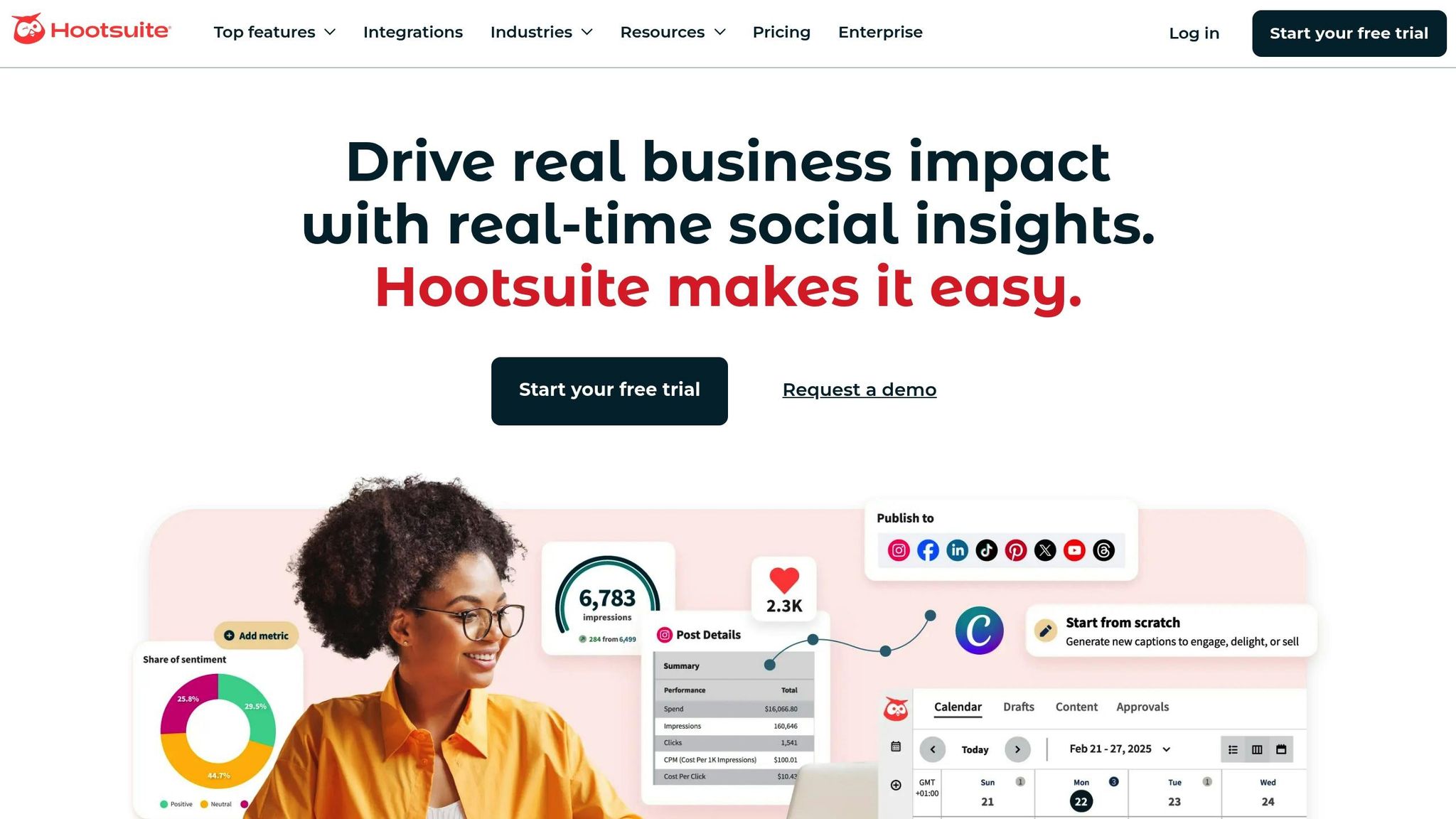
Hootsuite's free plan is a handy tool for small businesses looking to manage their social media presence without breaking the bank. It offers tools like scheduling automation and basic analytics, making it easier to maintain consistent engagement across platforms.
Here’s a closer look at what makes this plan a great fit for small businesses.
Budget-Friendly Features
With the free plan, you can manage up to three social media profiles, schedule as many as 30 posts per month, and access basic analytics to track performance and engagement. These features are perfect for fine-tuning your content strategy without spending a dime.
Tailored for Small Business Needs
Let’s face it - social media management can eat up a lot of time. Hootsuite’s scheduling tools simplify the process, letting you plan and post content efficiently. This means you can focus more on running your business while still keeping your social media active.
All-in-One Integration
Hootsuite works seamlessly with major platforms like Facebook, Instagram, Twitter, LinkedIn, and YouTube. Its centralized dashboard lets you manage everything in one place, so there’s no need to juggle multiple apps. Plus, it integrates with tools like Google Analytics, Mailchimp, and Canva, making your workflow even smoother.
Room to Grow
The free plan is a great starting point to build your online presence. As your business grows, you can upgrade to unlock features like unlimited scheduling, team collaboration, and advanced analytics - all while keeping your existing data intact. This makes scaling up your social media efforts a hassle-free process.
6. Zapier Free Plan
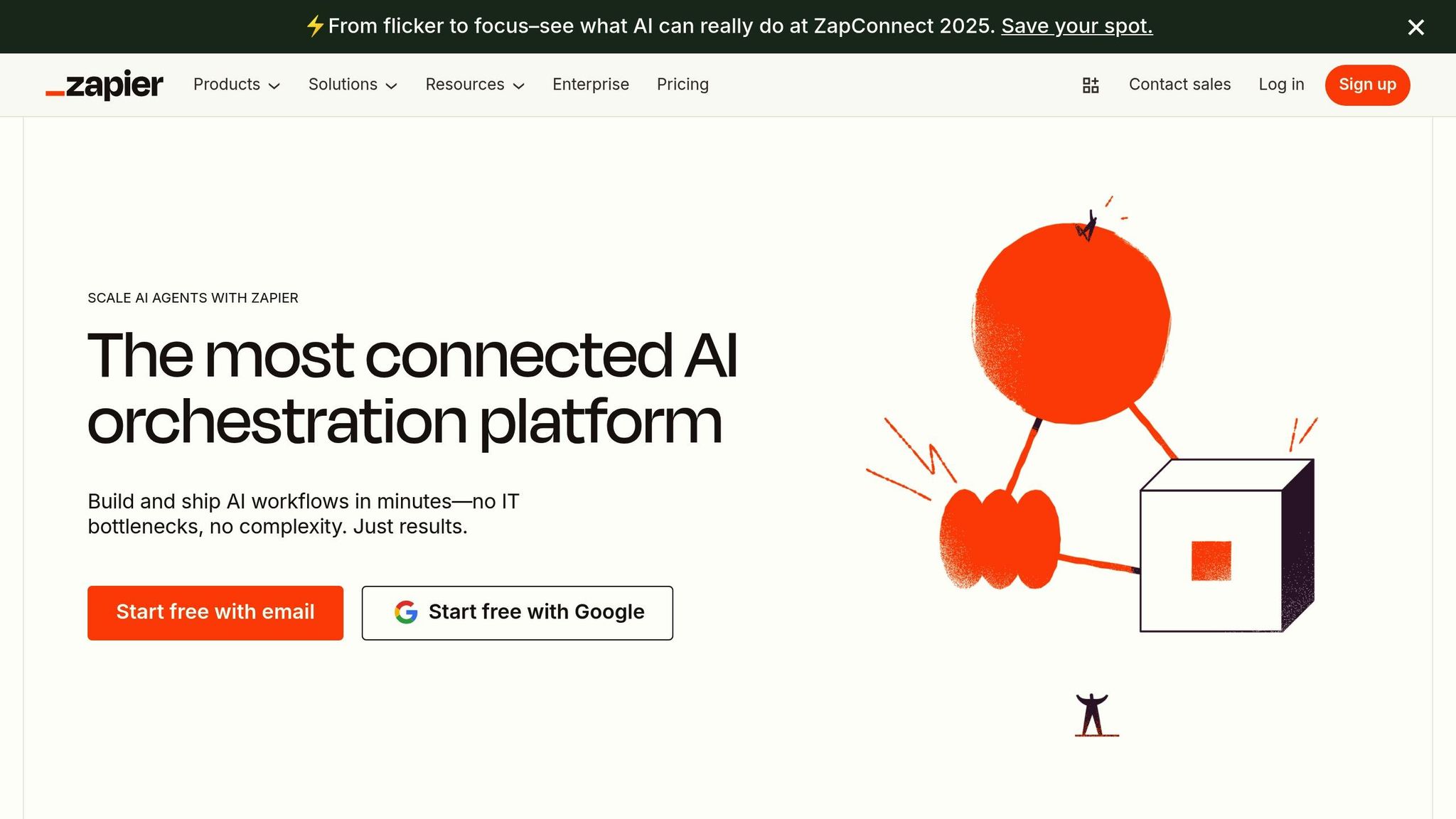
Zapier simplifies your workday by automating repetitive tasks, making it a must-have for small businesses looking to save time and effort. With its free plan, you can connect various apps and services using automated workflows called "Zaps." While the free tier comes with limits - like a cap on the number of tasks and single-step automations - it’s still a great starting point for streamlining everyday operations.
Cost-effectiveness
Zapier’s free plan allows you to automate common tasks without spending a dime. You can link popular tools like email, spreadsheets, communication platforms, and project management apps. Whether it’s adding new subscribers, sending notifications, or scheduling events, these automations cut down on repetitive tasks and free up your time for more strategic priorities.
Relevance to Small Business Needs
Small business owners often wear many hats, which makes automation a game-changer. Zapier addresses common pain points like data entry, lead tracking, and communication workflows by automatically handling these processes. For example, you can set up Zaps to save email attachments to cloud storage, update customer records when payments are made, or post updates to multiple social media channels - all without lifting a finger. This keeps your operations running smoothly and reliably, even when you’re busy juggling other responsibilities.
Ease of Integration with Existing Tools
Zapier’s user-friendly interface makes it easy to create Zaps, even if you’re not tech-savvy. Its visual workflow builder uses a straightforward trigger-and-action setup: when something happens in one app, Zapier performs a related action in another. With access to a massive directory of apps, you can seamlessly connect the tools you already use - whether that’s linking accounting software to invoicing platforms or syncing your CRM with email marketing services.
Scalability for Growing Businesses
The free plan is a great way to test the waters and fine-tune your workflows before committing to a paid plan. As your business grows and your automation needs evolve, Zapier’s premium options unlock features like multi-step automations and advanced integrations. This allows you to scale your automation efforts as your operations become more complex.
Many small businesses start with simple Zaps and gradually build out more sophisticated workflows, tackling tasks like customer onboarding or financial reporting. This step-by-step approach ensures your automation evolves alongside your business, supporting growth without overwhelming you.
7. ChatGPT Free Tier
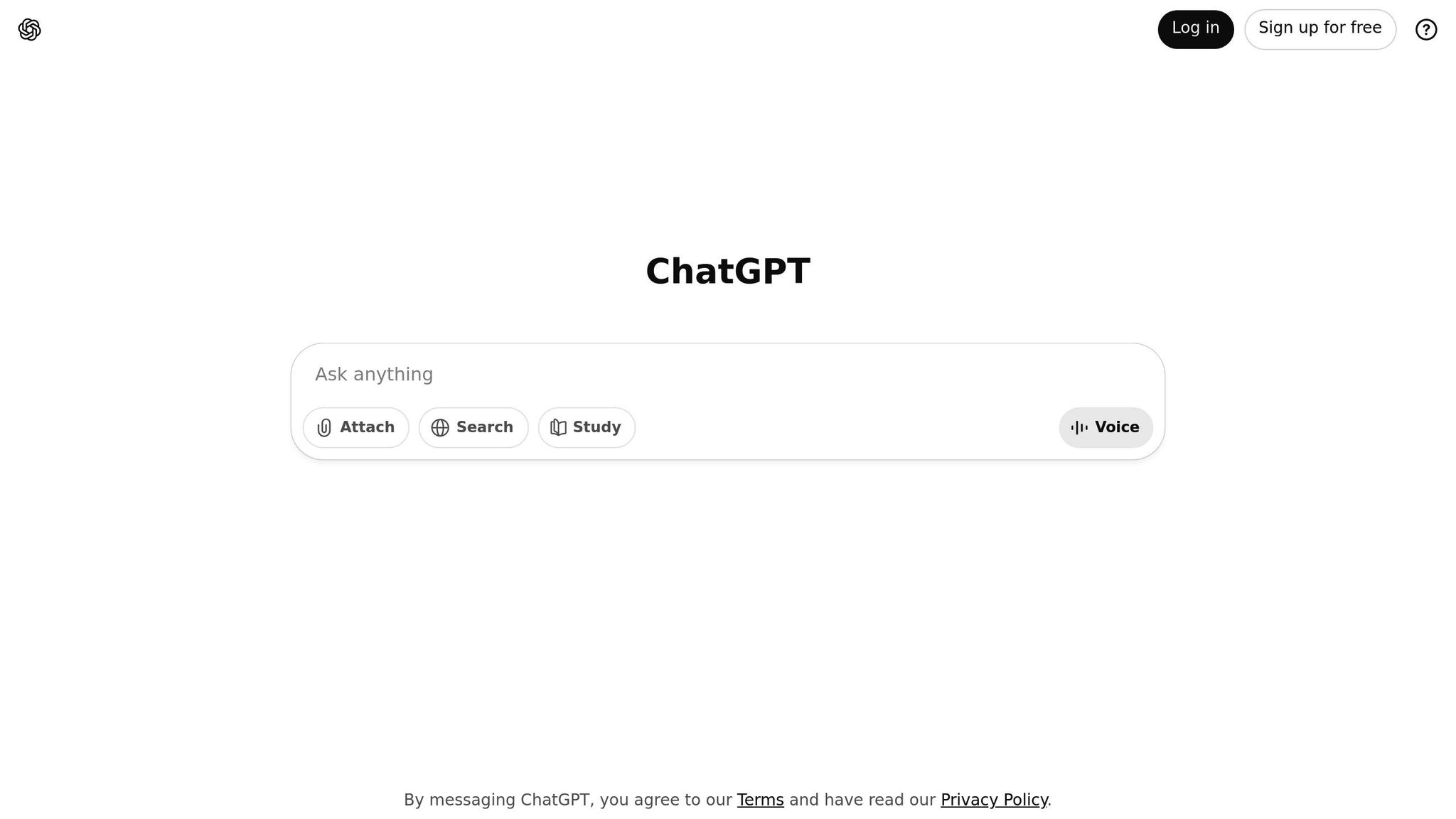
ChatGPT's free tier offers small businesses access to AI tools that can handle content creation, customer support, and other tasks, helping streamline operations even with some limitations.
Cost-Effectiveness
With GPT-3.5 powering the free tier, businesses can draft marketing copy, emails, social media posts, brainstorm ideas, and even tackle basic coding tasks. While there are caps during peak usage hours, this tool significantly reduces reliance on outside content creators, saving both time and money.
Meeting Small Business Needs
ChatGPT speeds up content creation by generating first drafts, headlines, and captions for social media. It also accelerates customer service tasks and simplifies writing projects like job descriptions, meeting agendas, or contracts. For solo entrepreneurs, ChatGPT can summarize trends or explain complex topics, making research faster and more manageable.
Easy to Use with Existing Tools
The web-based interface is straightforward and works on any device, requiring no technical setup or training. Many small businesses keep it open in a browser for quick help with tasks like writing emails, generating social posts, or brainstorming ideas.
Adapting to Business Growth
The free tier serves as a great introduction to AI for small businesses. As needs grow, upgrading to a paid plan unlocks more advanced features. Businesses often start with small tasks like email drafting and gradually expand to using ChatGPT for creating standard operating procedures, training materials, or analyzing customer feedback. This smooth transition makes it a reliable tool as your business scales.
Practical Use Cases and Implementation Tips
Small businesses across the U.S. are already seeing real benefits from free AI tools. By using platforms like AI Apps, these businesses are turning free resources into measurable gains. The key? Choose tools that address your biggest challenges and integrate them into your workflow. This approach builds on earlier strategies and highlights how practical applications can drive growth.
Start with Your Biggest Pain Points
The most successful AI implementations often begin by tackling tasks that eat up valuable time or offer little return. Take, for example, a bakery that spends hours daily responding to social media inquiries about custom orders. By using Hootsuite's free plan to schedule responses and ChatGPT to craft professional replies, they can save time while still maintaining a personalized touch.
Similarly, a freelance graphic designer might leverage Canva's free templates to create client presentations. These templates can then be customized with brand-specific elements, streamlining the design process without sacrificing quality or creativity.
Revenue-Generating Applications
AI tools can also be powerful allies in boosting sales. For instance, a small consulting firm could use HubSpot CRM's free tier to manage leads and employ ChatGPT to personalize follow-up emails, increasing the chances of conversion. Tools like Grammarly can further refine email copy, ensuring professionalism and building trust with potential clients - both critical for improving conversion rates.
A Smart Implementation Strategy
When adopting AI tools, take it slow. Start with one tool, test it, and expand from there. A great place to begin is the AI Apps directory, which offers advanced filters to help you find tools tailored to your business category and needs. Experiment with a tool during a trial period to see how it fits into your workflow before adding more.
Time-Saving Automation Combinations
Combining tools can be a game-changer for automating repetitive tasks. For example, with Zapier’s free plan, a lead filling out a website contact form can automatically be added to HubSpot CRM while triggering a Slack notification. Similarly, a local fitness studio could set up a workflow where new class bookings prompt welcome emails (drafted using ChatGPT and polished in Grammarly), update CRM records, and schedule follow-up social media posts - all running automatically to cut down on manual effort.
Enhancing Customer Satisfaction
AI tools don’t just save time - they can also improve how you interact with customers. Quick responses are crucial for customer satisfaction, and tools like ChatGPT can help you generate consistent, professional replies across multiple channels. Canva’s templates, on the other hand, ensure your social media posts, newsletters, and promotional materials always look polished, building trust and loyalty with your audience.
Measuring Success and ROI
To assess the impact of these tools, track metrics like time saved, response rates, and customer satisfaction. Many small businesses report noticeable productivity gains soon after implementing free AI solutions. Evaluating which tool combinations work best - whether it’s ChatGPT paired with Hootsuite for social media or HubSpot CRM alongside Grammarly for client communications - can help fine-tune your approach and maximize results.
Avoiding Common Pitfalls
One common mistake is trying to automate everything at once. Focus instead on repetitive, time-consuming tasks that don’t require complex decision-making. Always proofread AI-generated content to ensure it meets your standards. Using AI as a starting point, combined with your expertise, helps maintain quality and authenticity. And while free plans may have limitations, these restrictions often encourage small businesses to concentrate on essential features, avoiding the overwhelm of unnecessary extras.
Conclusion
In 2025, free AI tools have become a game-changer for small businesses, offering capabilities that were once exclusive to big corporations with hefty budgets. These tools provide real benefits in areas like marketing, customer service, operations, and productivity - all without requiring a large upfront investment. They make it easier than ever to integrate AI into every corner of your business.
The seven tools we’ve covered - ranging from AI Apps and HubSpot CRM to ChatGPT - help simplify processes, improve customer relationships, and drive revenue growth. The secret is in using them strategically: start with your biggest challenges and gradually build a toolkit that works smoothly together.
But here’s the thing: these tools aren't just about saving money. They offer a real edge by automating tasks like scheduling, creating stunning graphics, or connecting workflows. By using them, you can free up time to focus on high-level strategies that truly grow your business.
As AI continues to evolve in 2025, staying updated on new tools and features is critical. Platforms like AI Apps make this easier by offering a curated directory and advanced filters to help you find exactly what your business needs.
Small businesses that embrace these tools thoughtfully are already seeing results - better customer satisfaction, smoother operations, and noticeable revenue boosts. With a smart approach to AI adoption, you can position your business to not just compete but thrive in an increasingly tech-driven world.
FAQs
How can small businesses protect customer data and stay compliant when using free AI tools?
Small businesses looking to safeguard customer data and stay compliant should focus on free AI tools that prioritize encryption and have clear data privacy policies. Choose tools that openly explain how they manage and store data, and make sure they comply with regulations like GDPR or CCPA.
It’s also crucial to keep your security protocols up to date and perform regular risk assessments. AI-powered compliance assistants can be a game-changer, automating tasks like tracking regulatory updates and ensuring data protection rules are followed. Before using any free AI tool, carefully review its terms of service to ensure it meets your security and compliance requirements.
How can small businesses effectively use free AI tools to improve their operations?
How Small Businesses Can Make the Most of Free AI Tools
To get the most out of free AI tools, small businesses should start by pinpointing their biggest needs. Whether it’s automating repetitive tasks, enhancing customer service, or improving workflows, knowing what you want to achieve is the first step.
When selecting tools, look for ones that integrate easily with your current systems - like your email platform or project management software. This helps you avoid disruptions and keeps things running smoothly.
Choose tools with simple, user-friendly interfaces and plug-and-play features that make adoption straightforward. Rolling out tools in phases can also be a smart move. It gives you a chance to test their effectiveness and tweak your approach before fully committing.
Finally, focus on automating routine tasks such as scheduling or data entry. This not only saves time but also boosts productivity, giving you more bandwidth to concentrate on growing your business.
How can small businesses evaluate the success and ROI of using free AI tools?
Small businesses can evaluate how well free AI tools are working by tracking key performance indicators (KPIs) such as increased revenue, reduced costs, and improved time efficiency. A straightforward way to measure impact is by comparing metrics from before and after integrating the AI tools to see measurable changes.
To figure out the return on investment (ROI), you can use this formula: (Net Benefits ÷ Total Costs) × 100. Net benefits might include savings from automated tasks or extra income generated through AI-powered insights. Make sure these results align with your business goals to confirm the tools are addressing your specific needs.
You can also use analytics platforms or the built-in reporting features many AI tools offer to keep an eye on performance. Regularly reviewing these metrics ensures you're getting value from the tools and that they’re contributing to your growth plans.
